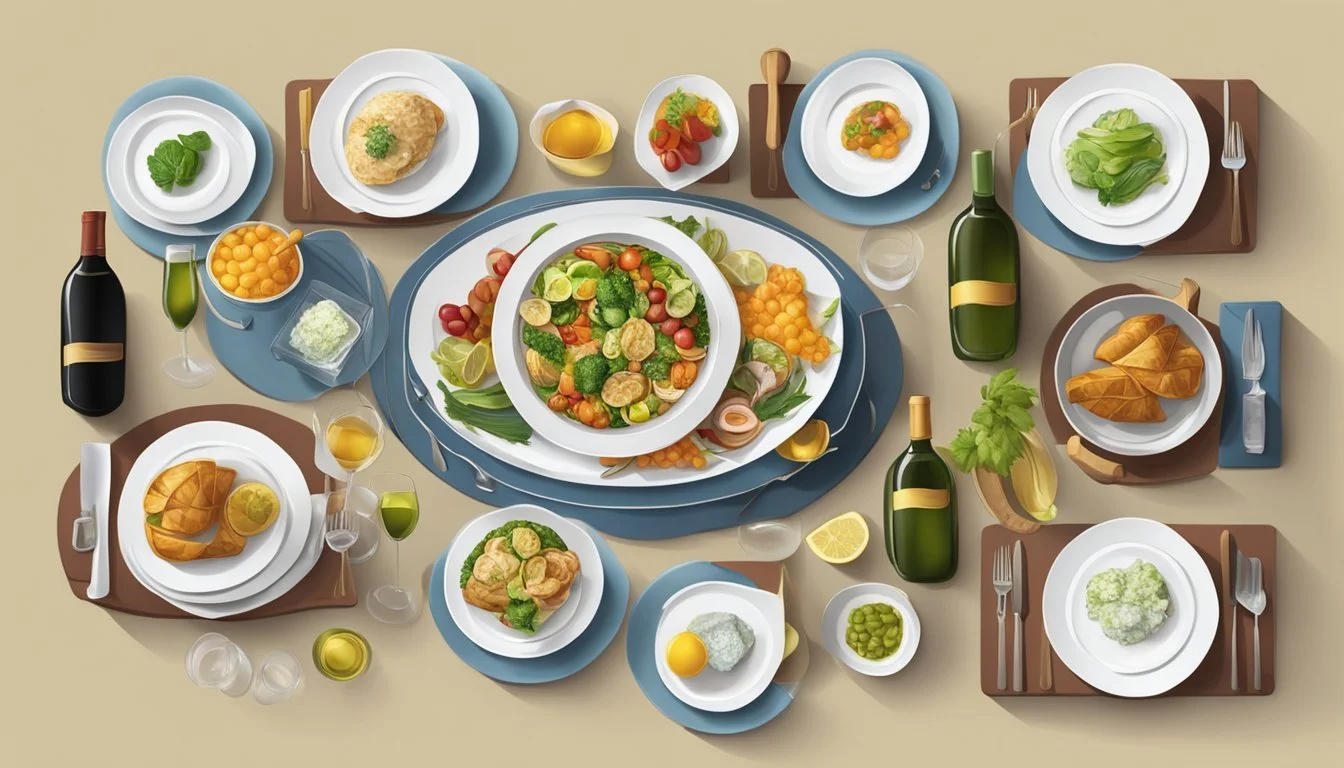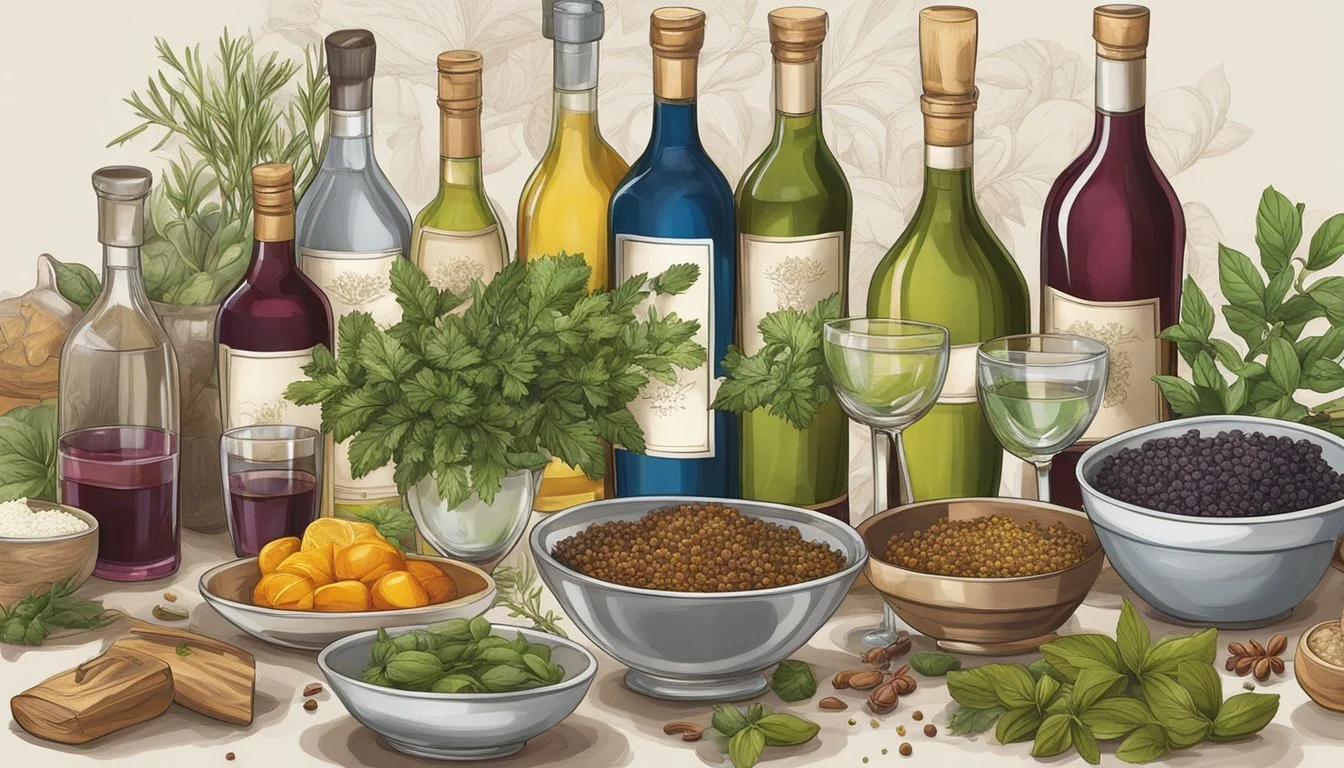Swicy Pairings with Wine and Spirits
Elevating Flavor Profiles
Exploring the realm of food and beverage pairings extends far beyond the classic combinations of wine and cheese or chocolate. As culinary and mixology arts continue to innovate, the idea of marrying the distinct flavors of spirits with various dishes has become an exciting gastronomic venture. Spirits, traditionally enjoyed on their own or in cocktails, are now being recognized for their potential to complement and enhance the flavors of a meal, offering a new dimension to dining experiences.
While wine pairing is a well-established practice, pairing spirits with food is gaining popularity for its ability to create unique taste experiences. From the peaty undertones of a single malt whisky enhancing the smokiness of grilled meats, to the crisp acidity of a chilled manzanilla sherry complementing the delicate flavors of smoked salmon, these "swicy" combinations open up a world of flavor. Spirits can offer a dynamic contrast to a dish's taste profile, bringing spicy, sweet, and umami elements into balance and allowing for an intricate dance between the beverage and the food on the palate.
Sweeter drinks are often a perfect counterpart for spicy dishes (What wine goes well with spicy dishes?), while bitter or complex spirits can be skillfully balanced with fatty foods to achieve a harmonious taste sensation. The interplay of contrasting flavors not only excites the palate but also highlights the unique characteristics of each pairing, providing a memorable dining experience that challenges and delights the senses.
Foundations of Food and Beverage Pairing
In the realm of culinary arts, the proper pairing of food and beverages is pivotal for enhancing the overall dining experience. Mastery in this craft is grounded in a comprehensive understanding of flavor profiles and the strategic utilization of acidity.
Understanding Flavor Profiles
Food and beverage pairings hinge upon the harmonization of flavor profiles. The array of flavors—salty, sweet, bitter, sour, and umami—need to be matched in a way that one does not overpower the other. For instance, a dish with a dominant salty character pairs well with a beverage that has a sweet or acidic profile, creating a balance on the palate.
Sweet: Complements spicy dishes by counteracting the heat.
Salty: Ideal with sweet drinks, creating a contrast.
Bitter: Pairs with foods that have a similar intensity or with sweet elements.
Sour: Cut through the richness of fatty foods.
Umami: Enhances the savory notes when paired with complex wines.
The Role of Acidity in Pairings
Acidity in beverages is a critical factor that elevates the taste of a dish. It acts almost like a palate cleanser, cutting through richer, heavier foods and creating a sensation of balance. In the world of wine, acidity is what gives the drink its tartness, important for pairing with fatty and creamy dishes.
White Wines: Typically higher in acidity, pair well with seafood or poultry.
Red Wines: Generally less acidic than whites, complement red meats (What wine goes well with red meat?) and hearty food.
Spirits: Can have varying levels of acidity, so one should consider the base of the spirit and its method of distillation when pairing with food.
Wine Pairing Basics
An understanding of wine labels, pairing principles including the balance of flavors, and the influence of tannins and body is essential to master the art of wine pairing.
Decoding Wine Labels
Wine labels are akin to a wine's resume, containing valuable information that can hint at the experience in the bottle. The vintage indicates the year the grapes were harvested, which influences the wine's qualities due to weather patterns. The varietal or grape type can determine the general flavor profile and body of the wine. For example, Cabernet Sauvignon is typically full-bodied with high tannins, while Pinot Noir is more medium-bodied with lower tannins.
Wine Pairing Principles
The primary goal is to match wine with food in a way that enhances both. Wines should match the intensity of the food; bold red wines go well with rich meats, while delicate white wines complement lighter dishes. Sweetness in wine can balance spiciness in food, making it a rule of thumb that the wine should be at least as sweet as the dish it accompanies.
The Influence of Tannins and Body
The structure of a wine, contributed largely by tannins and body, plays a significant role in pairing. Tannins, found predominantly in red wine, offer a sensation of dryness and astringency, which can be softened by the fat content in hearty meats. A wine's body—whether light, medium, or full—should correspond to the weight of the dish; fuller-bodied wines can stand up to more robust flavors, whereas light-bodied wines are best with more subtle fare.
Perfect Pairings for Spicy Profiles
The intricate dance of heat and flavor in spicy dishes requires thoughtful selection of wines and spirits that complement without overwhelming. Certain wines are lauded for their ability to balance and enhance the spicy profiles of diverse cuisines.
Spicy Asian Cuisine
For the complex flavors and often fiery heat of spicy Asian dishes, Riesling stands as a true ally. Its natural sweetness and high acidity create a harmonious contrast with the spice. Specifically, a German Riesling with its lower alcohol content doesn't amplify the heat but rather soothes the palate.
Pairings for Spicy Asian Cuisine:
Riesling: German Kabinett or Spätlese styles
Grüner Veltliner: Offers spice notes that echo Asian cuisine's own herbal flavors
Heat and Herbaceous Wines
When dealing with herbs and spices, one seeks a wine that can counterbalance the intensity with a touch of herbaceous quality. Grüner Veltliner, with its notes of white pepper and stone fruits, proves to be an excellent choice. Its grounding earthiness can enhance spice without overshadowing the dish’s complexity.
Pairings for Heat and Herbaceous Flavors:
Grüner Veltliner: For dishes with green herbs and mild heat
Gewürztraminer: Its aromatic profile stands up to hearty spices
Latin and Spicy Heat
Latin dishes, with their robust use of chilies and bold spices, find a companion in wines that carry their own weight. Syrah, with its dark fruit and peppery undertones, complements these spicy profiles. It is bold enough to stand alongside dishes with significant heat and spices, matching their vigor with its full-bodied presence.
Pairings for Latin and Spicy Heat:
Syrah: Look for bottles from cooler climates to ensure a balance of fruit and spice
Zinfandel: Its ripe berry notes can cool the palate against aggressive heat
Selecting Spirits for Swicy Dishes
When selecting spirits to accompany swicy (sweet and spicy) dishes, one should consider the intensity of both the dish's spice and the spirit's flavor to ensure a complementary pairing.
Cocktails and Spices
For swicy dishes that incorporate a blend of sugars and spices, such as those with cinnamon or chilies, cocktails offer a versatile pairing option. Cocktails with a dry profile, like a classic martini, can balance dishes with a single spicy accent, like wasabi or ginger. When dealing with complex spice profiles, a cocktail that mirrors some of the dish's ingredients, such as a bourbon cocktail with a hint of cinnamon, could create a harmonious match.
Herbal cocktails: Gin-based drinks can cleanse the palate between bites of swicy food.
Sweet cocktails: Pair with dishes where the spicy element dominates, to offset heat.
Straight Spirits with Fiery Foods
Selecting straight spirits for fiery foods, which often incorporate intense spices like black pepper, requires attention to the spirit's body and intensity. Lighter spirits might be overshadowed by the spice, while spirits with more character, such as a smoky bourbon or a peppery rye whiskey, can stand up to robust flavors.
Lighter spirits: Vodka or light rum can pair with mildly spiced foods without competing for dominance.
Heavier spirits: Añejo tequila, aged rum, or full-bodied cognacs are well-suited for rich, swicy dishes.
Choosing the right spirit for swicy dishes can elevate the dining experience, creating a delightful interplay between the heat of the food and the complex notes of the spirit.
Fresh and Light: Wine Options for Delicate Dishes
When pairing wines with delicate dishes, the goal is to enhance the flavors without overpowering them. Fresh and light dishes (What wine goes well with light dishes?) demand wines that can complement their subtlety and range from the sea's bounty to earth's vegetarian offerings.
Seafood and Crisp Whites
Certain white wines excel when paired with seafood. Two varieties stand out:
Sauvignon Blanc: This crisp white wine is a classic match for lighter seafood dishes. (What wine goes well with seafood dishes?) Its zesty acidity can elevate the natural flavors of sushi and oysters.
Pinot Grigio: With its bright citrus notes, Pinot Grigio pairs well with shellfish, enhancing the light and fresh qualities of the dish.
For ideal pairings, consider:
Seafood Type Wine Recommendation Sushi Sauvignon Blanc Oysters Chilled Sauvignon Blanc or Pinot Grigio Shellfish Crisp Pinot Grigio
The clean and refreshing profiles of Sauvignon Blanc and Pinot Grigio mirror the simplicity and purity of these seafood options.
Vegetarian Fare and Versatile Vinos
Vegetarian dishes (What wine goes well with vegetarian dishes?) often feature an array of flavors that can be complex to match. Light, aromatic wines can complement these without overwhelming the palate:
Sauvignon Blanc: Its herbaceous notes can bring out the flavors in green, leafy dishes.
Pinot Grigio: A light-bodied Pinot Grigio can pair with a variety of vegetarian ingredients, retaining the freshness of the meal.
A practical pairing guide:
Vegetarian Ingredient Wine Recommendation Green Salads Sauvignon Blanc Light Pastas Pinot Grigio
Both wines have the versatility to balance a wide range of vegetarian dishes, from crisp salads to delicately seasoned pastas.
Robust Reds and Rich Meals
Robust red wines such as Cabernet Sauvignon, Zinfandel, and Shiraz pair exceptionally well with red meat, particularly when grilled or barbecued. These full-bodied wines complement the rich flavors of the meats, creating a harmonious dining experience.
Steaks and Full-Bodied Reds
Steak is a classic partner for full-bodied red wines. A well-marbled ribeye or New York strip steak, when grilled, has a rich texture that requires a wine with enough structure to match.
Cabernet Sauvignon: Its bold tannins and notes of dark fruit are ideal for red meat.
Zinfandel: A wine that offers a fruit-forward profile with a hint of spice, pairing well with barbecued steak.
Wine Type Steak Cut Preparation Notes Cabernet Sauvignon Ribeye Grilled Tannins cut through the fat, enhancing the flavors. Zinfandel New York Strip Barbecued Spiciness complements charred exterior.
Hearty Stews and Complex Wines
When it comes to hearty stews featuring red meat, they demand a red wine with complexity to stand up to the rich flavors and textures involved.
Shiraz: Known for its peppery notes, it can elevate a beef or lamb stew.
Full-Bodied Red Blends: These can contribute to the depth of the dish with their layered flavors.
Wine Type Stew Base Key Characteristics Notes Shiraz Beef Peppery, bold Accentuates spices and savory notes in the stew. Full-Bodied Red Blends Lamb Complex, varied Complements the gamey taste of lamb.
The robustness of these wines is an essential counterpoint to these rich dishes (What wine goes well with rich dishes?), offering a palate experience that is both satisfying and complex.
Unique Wine Varietals and Food Pairings
In this exploration of the unusual, one finds a tapestry of flavors that challenge and delight the palate. The section below unveils unique pairings of lesser-known white wines and adventurous reds with a variety of foods.
Exploring Lesser-Known Whites
Viognier: This fragrant white wine, with its notes of stone fruit and floral aromas, pairs beautifully with spicy Thai dishes. The wine's natural sweetness and robust body complement the heat and complexity of Thai flavors.
Chardonnay (unoaked): Stepping away from the more common oaked varieties, unoaked Chardonnays bring a refreshing acidity that works well with sushi’s delicate tastes. Its zesty and pure expressions cleanse the palate between each piece.
Pinot Gris: This varietal’s versatility allows it to partner splendidly with both sweet and savory dishes. The slight sweetness of Alsatian-style Pinot Gris balances the richness of foie gras, while the wine's acidity cuts through the dish’s density.
Adventurous Reds and Food Adventures
Grenache: A lighter red with fruity and spicy undertones, Grenache finds its match in equally complex dishes like Moroccan lamb, where the wine’s ripe berry notes dance alongside the sweet and savory spices.
Barbera: Known for its high acidity and low tannins, Barbera is a delightful companion to tomato-based pasta dishes. Its bright cherry flavors and earthy notes enhance the tangy richness of a hearty Bolognese sauce.
Every wine varietal offers its own distinct profile, which can be used to elevate a wide array of culinary creations. From the potent florals of a crisp Viognier to the juicy depths of a supple Barbera, there is a world of food pairing adventures waiting to be discovered.
Global Cuisine Meets Wine and Spirits
Exploring the perfect pairings between global cuisine and wines or spirits can enhance dining into an exquisite experience. When selected thoughtfully, each sip can complement a dish flawlessly, revealing subtle tastes and aromas.
European Elegance and Old World Wines
The time-honored cuisines of Europe pair beautifully with Old World wines, encompassing a rich heritage and refined tastes. French cuisine, known for its sophistication, pairs exceptionally well with local wines. A buttery Chablis complements seafood dishes, while a robust Chianti stands up to hearty Italian meats and pasta.
Cuisine Dish Wine/Spirit French Coq au vin Chablis Italian Bolognese Chianti Spanish Paella Rioja
French cheeses also become more nuanced when enjoyed with a glass of Chablis, enhancing both the creaminess of the cheese and the crispness of the wine. Meanwhile, the tannins in Chianti embrace the richness of tomato-based pasta dishes, balancing the overall flavor profile.
New World Wines and American Classics
On the other side of the ocean, American classics like barbecued meats (What wine goes well with barbecued meats?) find their match in New World wines. For instance, a rich Malbec from Argentina is exceptional with smoky barbecue flavors, as the boldness of the wine stands up to the intensity of the dishes.
Cuisine Dish Wine/Spirit American BBQ ribs Malbec Californian Zinfandel burger Zinfandel
Crisp, chilled Prosecco surprisingly complements the delicate flavors of seafood pizza, with effervescence cutting through the richness. Lambrusco, slightly sparkling and fruit-forward, pairs well with the tangy cheeses and cured meats (What wine goes well with cured meats?) often found on American-style pizzas. This creates a satisfying contrast that heightens the enjoyment of each bite.
Sweet, Dry, and Everything in Between
Navigating the spectrum of wines can enhance the culinary experience, from the zing of high-acid dry wines cutting through rich dishes to the harmonious interplay of sweet wines with dessert.
Off-Dry Wines and Spicy Pairings
Off-dry wines, which possess a hint of residual sugar, can complement the heat of spicy foods beautifully. The slight sweetness in these wines doesn't overwhelm the palate but rather provides a pleasant contrast. A classic example is an off-dry Riesling or Gewürztraminer paired with spicy Asian cuisine. The residual sugar counters the intensity of the spices, while the high acidity typically found in these wines offers refreshment between bites.
Pairing Examples:
Off-Dry Riesling with Szechuan Chicken
Gewürztraminer with Thai Green Curry
Dessert Wines and Sweet Sensations
Dessert wines like Sauternes or Muscadet celebrate the luscious side of the spectrum, boasting high sugar levels that naturally align with sweet treats. These wines are crafted to hit the right balance of sweetness and acidity, preventing a cloying aftertaste. A glass of Sauternes, for instance, can elevate a simple dessert of fruit or pastry, creating a synergy between the sugar in the wine and the sweetness of the dish.
Pairing Examples:
Sauternes with Foie Gras or Blue Cheese
Muscadet with Fruit-based Desserts (What wine goes well with fruit-based desserts?)
When selecting a wine, consider the sweetness, acid level, and whether it's dry, to ensure a harmonious pairing with your meal.
Expert Tips and Techniques
In the realm of wine and spirit pairings, understanding both the harmony and the balance that can be achieved through congruent and contrasting flavors is crucial. Temperature and glassware also play vital roles in appreciating the nuances of these pairings.
Mastering Congruent and Contrasting Pairings
Congruent pairings involve matching wine or spirits with food that share common flavors or profile characteristics. For example, a buttery Chardonnay is a congruent pairing with creamy seafood dishes because the rich textures and buttery notes in both the wine and food complement each other.
On the other hand, contrasting pairings create balance by opposing flavors, textures, or both. A tart, high-acid wine like Sauvignon Blanc contrasts beautifully with a rich, fatty fish, such as salmon. The acidity cuts through the fish's richness and cleanses the palate.
For congruent pairings:
Identify the dominant flavors in the food and seek out a wine with similar flavor notes.
Match rich foods with wines that have a comparable depth of flavor.
For contrasting pairings:
Pair spicy dishes with sweet wines to cool the heat, such as a Riesling with spicy Asian cuisine.
Choose high-tannin wines to balance dishes with a high level of fat content, which softens the astringency of the tannins.
The Importance of Wine Temperature and Glassware
Wine temperature significantly affects the tasting experience as it can alter the bouquet, flavor, and overall profile of the wine. Red wines should generally be served slightly below room temperature, between 62-68°F (16-20°C). White wines and rosés are best served chilled, around 49-55°F (9-13°C). Sparkling wines and champagnes reach their optimal taste at even cooler temperatures, between 38-45°F (3-7°C).
Proper glassware is another element that should not be overlooked. The shape of the wine glass can enhance or diminish the aromatics and taste of the wine.
Red Wines: Typically served in larger, rounder glasses which allow for better oxygenation and release of complex aromas.
White Wines: Served in glasses with narrower bowls to preserve floral and fruit aromas and maintain a cooler temperature.
Sparkling Wines: Best enjoyed in tall, thin glasses that promote bubble formation and concentrate the bouquet.
Incorporating these expert tips and techniques into your cooking and preparation can transform the dining experience, elevating both the dish and the chosen wine to new heights.
Pairing Wine and Spirits with Herbs and Spices
Pairing the right wine or spirit with specific herbs and spices can enhance the flavors of both the drink and the food. This section covers how aromatic white wines can elevate fragrant herbs, and how bold reds can complement strong spices.
Aromatic Whites and Fragrant Herbs
Aromatic white wines possess a natural affinity for fragrant herbs. These wines, often noted for their perfumed nose and zesty palates, align beautifully with the delicate nature of certain herbs.
Mint: Fresh and vibrant, mint pairs well with Riesling. The wine's sweetness complements mint's cool flavor.
Sage: Its earthy and slightly peppery notes are complemented by the crispness of Pinot Grigio.
Herb Wine Suggestion Garlic Sauvignon Blanc Rosemary Vermentino Lavender Gewürztraminer Cilantro Grüner Veltliner
Herbs like lavender and anise may also find their match in spirits. Lavender's floral notes can be echoed in a gin with a botanical profile, while anise's licorice-like flavor can be enhanced by anise-flavored spirits like Pastis.
Bold Reds and Strong Spices
Bold red wines can stand up to the intensity of strong spices without being overpowered. Rich, full-bodied wines match well with the depth and warmth of many spices.
Rosemary: Its piney scent and earthy flavor stand strong against the boldness of a Cabernet Sauvignon.
Anise: The subtle sweetness and licorice notes of anise go hand in hand with the spicy hints in Zinfandel.
Spice Wine Suggestion Paprika Shiraz Cayenne Malbec Turmeric Chianti
Spirits such as whiskey, particularly those with a spicy rye profile, enhance the warmth of spices like cayenne. Meanwhile, the smoky qualities of a good mezcal can harmonize with spices such as smoked paprika, elevating dishes with a piquant kick.
Seasonal and Special Occasion Pairings
Seasonal events and special occasions present perfect opportunities to create memorable meal experiences by pairing foods with appropriate wines and spirits. Factors such as weather, seasonal produce, and festive themes influence the selection of pairings that can enhance the flavors of both the food and the drinks.
Holiday Feasting and Festive Bubbles
During the holiday season, the focus is often on rich meals with poultry like chicken and turkey. These traditional centerpieces are best complemented by wines with a vibrant acidity and a hint of minerality to cut through the fatty profiles. Champagne and Prosecco are exquisite choices due to their effervescence and capacity to cleanse the palate. For a refined pairing:
Champagne: Pairs well with turkey, bringing out the meat's delicacy through its persistent bubbles and balancing acidity.
Prosecco: A lighter, fruitier option suitable for chicken and less dense meat dishes, offering a gentle fizz and often a hint of sweetness that can complement a range of holiday flavors.
Summer Grilling and Refreshing Sips
In contrast, summer gatherings often feature outdoor grilling where the smoky char of meats and vegetables yearn for refreshing and uplifting drinks. During this time, the drink of choice should contribute to the cooling down of the palate as well as elevating the freshness of salads and grilled dishes.
Sparkling Wine: A versatile partner for summer grilling; the carbonation in sparkling wines helps to lift the flavors of grilled chicken and refresh the taste buds after each bite.
Chilled White Wines: Varietals with high acidity, such as Sauvignon Blanc or Grüner Veltliner, are perfect for pairing with salads, offering a crisp contrast to the greens and vinaigrettes.
By selecting the proper wine or spirit for each seasonal event or special occasion, one can turn a regular meal into a festive celebration.
Pairing Wine with Cheeses and Charcuterie
Selecting the right wine to complement cheeses and charcuterie (What wine goes well with charcuterie?) enhances the tasting experience. The choice of wine can highlight the flavors of both the cheese and the meats, creating a harmonious balance that pleases the palate.
Creating the Perfect Cheese Board
When assembling a cheese board, consider the textures and flavors of the cheeses and how they will pair with selected wines. Chardonnay, with its buttery notes, pairs well with semi-hard cheeses such as Gruyère. A crisp rosé tends to complement soft and creamy cheeses, like Brie or Camembert, without overpowering their delicate flavors.
Hard Cheeses: Pair with full-bodied wines like Cabernet Sauvignon.
Soft Cheeses: Match with light-bodied wines such as Chenin Blanc or rosé.
Blue Cheeses: (What wine goes well with blue cheeses?) Balance the strong flavors with sweet wines like Riesling.
Tips for Cheese and Wine Pairing:
For bolder cheeses, choose wines with more character.
Serve cheeses at room temperature to fully appreciate their flavors.
Charcuterie: Finding the Right Wine
Charcuterie requires wines that can stand up to the rich and often salty flavors of cured meats.
Pinot Noir, known for its versatility, pairs excellently with a wide range of meats, including delicate prosciutto and spicier salami. The fruity undertones and lighter body ensure that the wine does not overwhelm the taste of the charcuterie.
A structured pairing guide for charcuterie might include:
Meat Type Wine Recommendation Mild Cured Meats Light reds such as Beaujolais Spicy Cured Meats Bold reds like Zinfandel Rich Pâtés Full-bodied whites like Viognier
Key Points for Charcuterie and Wine Pairing:
Pair lighter wines with less intense cured meats.
Opt for wines with higher acidity to cut through the fat of richer meats.
By paying close attention to these pairing principles, one ensures each sip and bite is an experience to savor.










